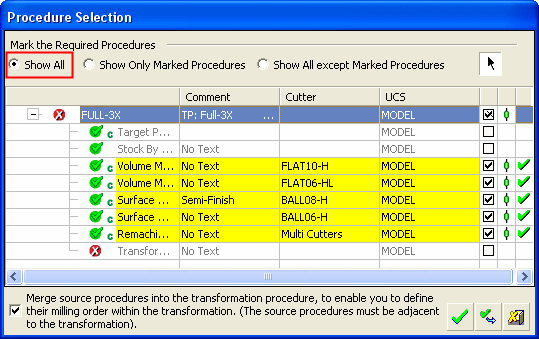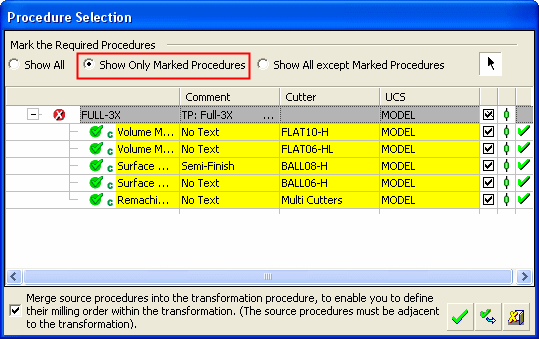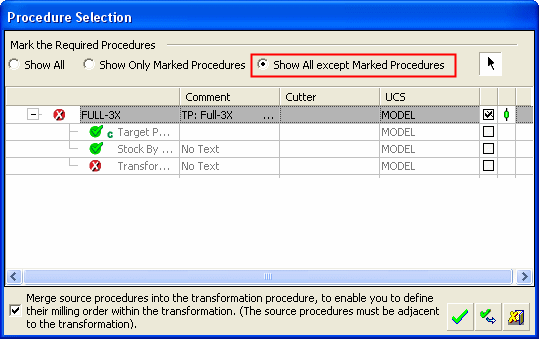Picking Procedures (for Transformation)
Access: Open this function from the following location:
-
Procedures selection mode:
Either press the button in the Work Mode Dialog (if you are in Wizard Mode), or display the Geometry parameters in the parameter tables.
button in the Work Mode Dialog (if you are in Wizard Mode), or display the Geometry parameters in the parameter tables.
The Geometry Table is displayed:

To start picking the procedures, press the numbered button adjacent to the Procedures geometry parameter. This button displays the number of procedures that have already been selected. You are then prompted to pick the required procedures to be transformed.
See Selecting / Unselecting Geometry.
See the cursor symbols in Cimatron when picking geometry.
The Procedures option in the Geometry table enables you to pick the procedures which are to participate in the transformation operation.
The Procedure Selection dialog is displayed:
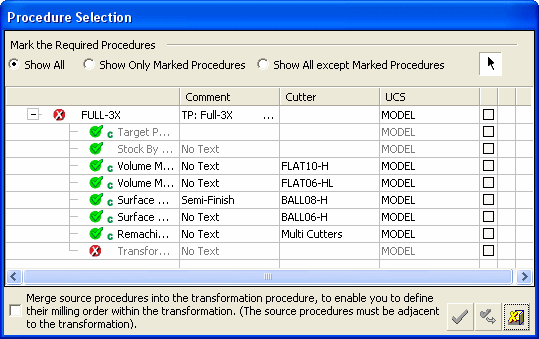
The body of the dialog includes the following:
-
List all the toolpaths and procedures that precede the current transformation procedure. The status flags and symbols that appear in this column are the same as those in the Process Manager.
-
Any comment that is attached to a toolpath and/or procedure.
-
The cutter type used in each procedure.
-
The UCS used in each toolpath and procedure.
-
Checkbox for selecting toolpaths and/or procedures which are to participate in the transformation operation.
From this dialog:
-
Pick the procedures which are to participate in the transformation operation.
-
If required, merge source procedures into the transformation procedure.
-
Select the associativity.
-
Select the appropriate approval option.
Picking Procedures
Using this dialog, any non-stock or part procedure (even another transformation procedure) that precedes it can be selected, even if it is in another toolpath folder.
To select procedures (or toolpaths) which are to participate in the transformation operation, set the arrow button (on the top row of the dialog) as required and then pick the procedures (or toolpaths):
|
|
Select the procedures (or toolpaths) only by selecting the appropriate checkbox in the dialog. |
|
|
Select the procedures (or toolpaths) either by picking them in the graphics area (picking them individually or by box) or by selecting the appropriate checkbox in the dialog. This is the default option. |
When selecting the procedures (or toolpaths) from the dialog, they can be selected using one of the followings methods:
-
Selecting the appropriate checkbox(es) - either the individual procedure checkboxes or toolpath checkboxes.
In the example below, the toolpath checkbox is selected to select all the procedures in the toolpath (the selected procedures are highlighted in yellow and their checkboxes are marked as selected  ).
).
Note: The toolpath checkbox is marked  to indicate that some of the checkboxes remain unselected (
to indicate that some of the checkboxes remain unselected ( ).
).
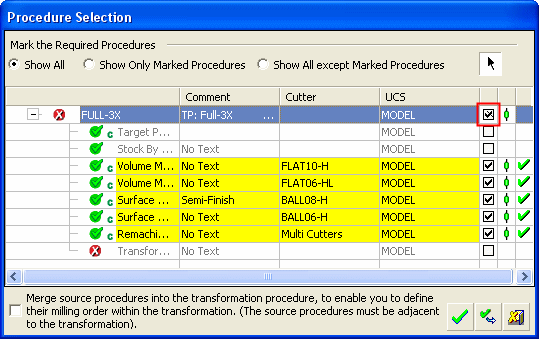
-
Selecting via a popup menu. In this case:
Select the required procedures (or toolpaths) and right-click to display the popup menu:
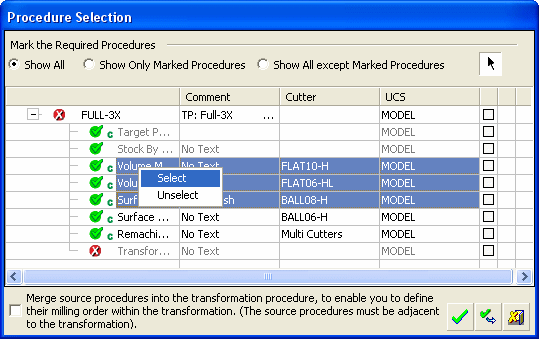
Choose the Select option. The required items are marked as selected:
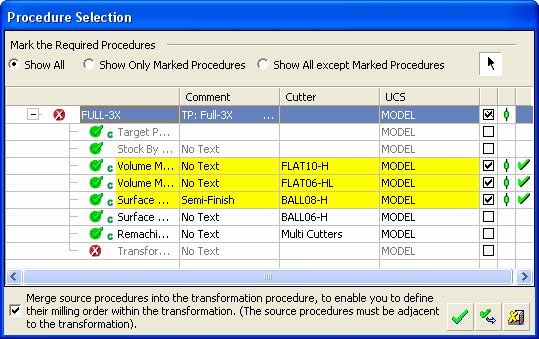
Note: Once procedures (or toolpaths) have been selected in the dialog, additional options are displayed in the popup menu; see Associativity.
The following display options are available at the top of the dialog:
|
Show All |
Show all the toolpaths and procedures that precede the current transformation procedure.
|
|
Show Only Marked Procedures |
Show only the toolpaths/procedures that have been selected to participate in the transformation operation.
|
|
Show All except Marked Procedures |
Show only the toolpaths/procedures that have not been selected to participate in the transformation operation.
|
Associativity
The  /
/  sign signifies the associativity with source procedures.
sign signifies the associativity with source procedures.
The Transformation procedure is, by default, associative to the source procedure(s). However, you can disassociate individual items by right-clicking on the appropriate row and selecting Non-Associative from the popup menu (this toggles  to
to  , and vice versa if you select Associative from the menu).
, and vice versa if you select Associative from the menu).
|
|
Indicates that the Transformation procedure is associated to the source procedure. This means that any changes to the source procedure results in a flag being displayed in the Transformation procedure; rerunning the Transformation procedure will change the result according to the change in the source procedure. |
|
|
Indicates that the Transformation procedure is disassociated from the source procedure. This means that any changes to the source procedure will not have any affect on the Transformation procedure or its result. |
To change the associative in the dialog:
-
Select the required items and right-click to display the popup menu:

-
Select the required associativity option; in this case Non-Associative was selected:
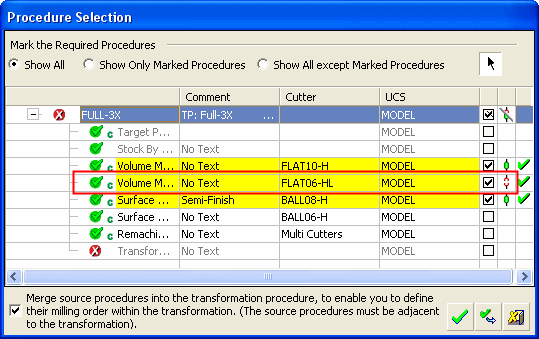
Note that, for the selected item, the  has toggled to
has toggled to  to indicate non-associativity. Note also, that the toolpath associativity is marked as
to indicate non-associativity. Note also, that the toolpath associativity is marked as  to indicate that there is mixed associativity amongst its procedures.
to indicate that there is mixed associativity amongst its procedures.
Merge Source Procedures
A checkbox appears at the bottom of the dialog. Selecting the checkbox combines the toolpath of the source procedure(s) with those of the transformation(s). This allows you to sort the complete toolpath. To make this possible, the source toolpath and its transformation(s) cannot be separated by procedure(s) that are not included in the transformation.
Approval Options
The following approval options are available when picking motions for transformation:
|
|
OK. Accept the picked motions for transformation and close the dialog. |
|
|
Apply. Accept the picked motions for transformation and remain in the dialog. |
|
|
Cancel. Exit the dialog and cancel any selections. |
 (button off)
(button off) (button on)
(button on)